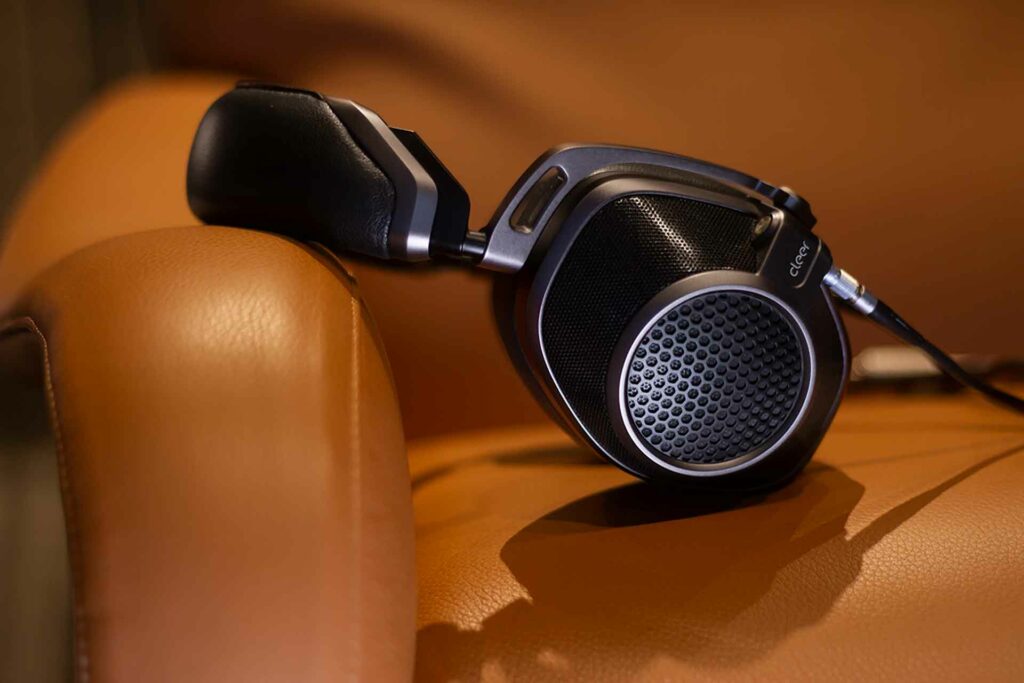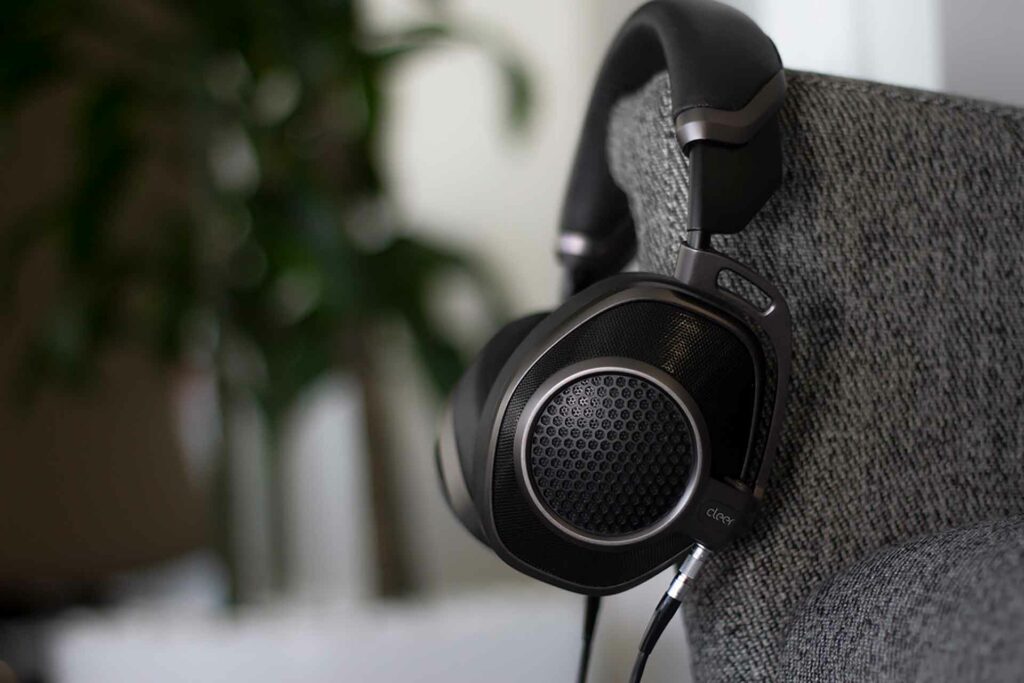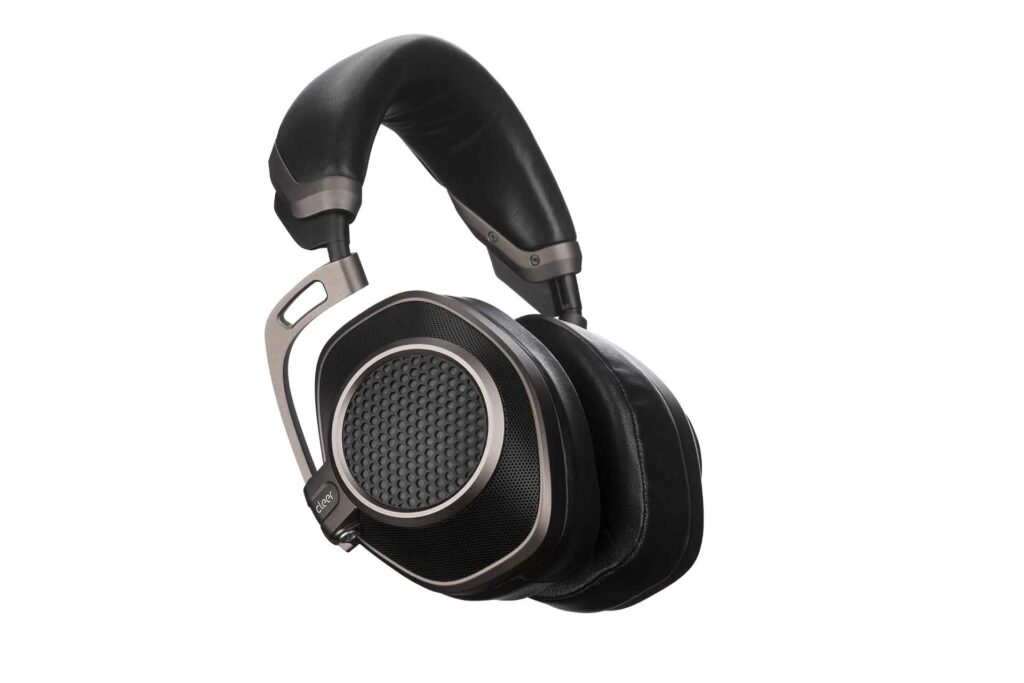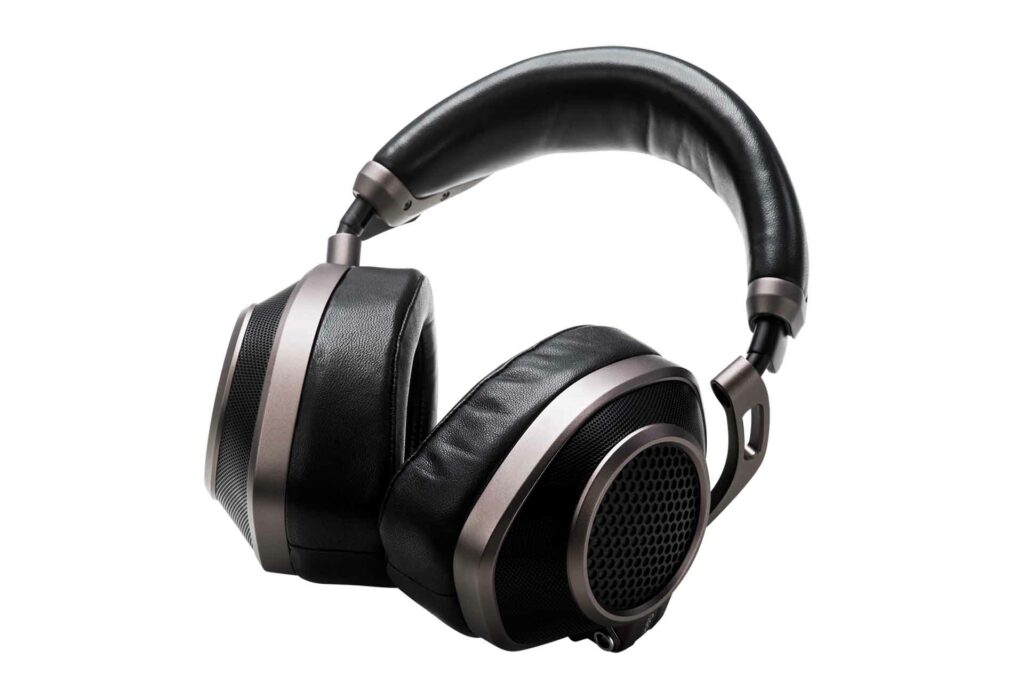You may be surprised to learn that Cleer Audio sells an audiophile-oriented, wired-only audiophile headphone set. Cleer’s primary user base consists of younger, on-the-go listeners who are seeking headphones that perform at a higher level but also look really cool. The $699 Cleer Next (buy at Crutchfield) follows that narrative in price, looks, and performance, but there’s no Bluetooth, microphones, or noise cancelling to be found. These over-ear headphones caught our eye at FutureAudiophile.com because they embody the design traits of traditional, high-end audiophile headphones—but with a modern aesthetic twist and a price that’s notably lower than the headphones they were designed to compete against. This pair’s passive, open-back concept requires a significantly different design approach, and we were curious to see if Cleer’s engineering abilities were up to the task.

What Makes the Cleer Next Headphones Special?
- The Cleer Next headphones feature a sturdy chassis made from 6061-T6 aluminum and finished in a bronzish “titanium” color, which contrasts nicely with the black sheepskin leather and other accents. The earcups connect to the headband in a half-gimbal design, and the overall design has a subtle steampunk vibe. Cleer utilized the services of BMW’s Designworks—based in Newbury Park, California—to create the Next’s industrial design.
- The aluminum chassis and solid build quality mean that the Next headphones don’t weigh in as a featherweight, but they’re still a reasonable 400 grams, or 14.1 ounces. The bottom of each earcup has a LEMO push-pull connector to which a 6.6-foot, quad-core cable connects.
- Inside each open-back earcup, you’ll find a proprietary 40mm magnesium alloy diaphragm driver, which is designed to provide a maximum stiffness-to-mass ratio while also maintaining proper dampening. The drivers utilize Cleer’s “ironless driver” technology in which 20 non-iron, rare-earth magnets are arrayed in a ring formation. Cleer claims that this provides better voice-coil control while minimizing distortion by providing a more evenly balanced magnetic field.
- The Cleer Next headphones have a low impedance rating of 16 ohms, a stated frequency response of 10 Hz to 45 kHz, and a sensitivity of 92 dB at 1 watt meter. They aren’t impossible to drive, but the addition of even a modest headphone amp can be beneficial.
- The lambskin-covered, memory-foam headband and earpads are comfortable—and even made a good seal around my eyeglasses. The earpads have a three-dimensional wedge, getting wider at the backs and bottom—which provided a comfortable, stable fit around my ears.
Why Should You Care About the Cleer Next Headphones?
Everybody loves the convenience of wireless headphones, but anybody who has taken the time to compare their performance with similarly priced wired headphones knows that the wired ones usually sound better. They come in more exotic configurations, and if you can live with being tethered to a device (especially a small headphone amp), prepare yourself for some pretty amazing sound. These Cleer open-back headphones are not suited for use on a plane or at the gym, but they were an excellent, late-night alternative to my often-raucous reference AV system with its big subwoofers. A really good pair of wired headphones is a perfectly reasonable audiophile accessory that will pay musical and lifestyle dividends.

Some Things You Might Not Like About the Cleer Next Headphones
- The relatively low 16-ohm impedance means these headphones can be driven by most mobile devices, but the 92-dB sensitivity rating means that they will not play terribly loud through your phone or tablet’s headphone output.
- My only complaint regarding comfort was a small pressure point in the center of the Next’s headband.
- The carrying pouch is made of soft, synthetic leather with a faux fur lining and internal cable pocket. While fine for storage on a shelf at home, the pouch provides little to no protection if you want to carry the headphones around with you.To my ears, there is a slight bump in the treble range. This seems to be common with audiophile-oriented open-back headphones, as it gives them a little bit of extra detail or sizzle in the high frequencies to help offset the typically soft sound of open-back designs. As a result, some might find the Cleer Next to sound ever-so-slightly bright, but I liked the overall tonal balance.
- Replaceable earpads would extend the life of the headphones, but Cleer doesn’t offer this option. I would also love the option of a fabric-covered cushion for the headband.
Listening To The Cleer Next Headphones
I did my listening using both an Astell & Kern Kann Cube portable music player and an Apple iPad Air. The Next headphones were generally easy to drive with both devices; they did not lose their composure or sound muddled. The Astell & Kern player sounded louder, but the iPad Air was loud enough for me to be more than satisfied in the volume department. The Astell & Kern player also delivered better overall dynamics and slightly more detail. It was not a night-and-day difference, but the Astell & Kern provided more texture and a better sense of space than the iPad.
The opening notes of Pink Floyd’s all-time audiophile classics “Speak to Me” and “Breathe” from Dark Side of the Moon (Qobuz, 24-bit/96-kHz) revealed the Next’s excellent detail. The bass notes sounded deep and weighty, yet also taut and detailed. With “Breathe,” the Cleer Next reproduced David Gilmour’s vocals clearly and distinctly from the many effects and instrumentals. The effects panned smoothly around my head without any noticeable gaps or drop-offs. Overall, this record I’ve all heard a million times sounded pretty fantastic.
Listening to Jennifer Warnes’ “Bird on a Wire” (Tidal HD streaming) —a track I am beyond familiar with—I could tell that the vocals sounded more forward in the mix than what I am used to hearing with most headphones, but the relative positioning of the instruments was as expected, with a wide, detailed, and lovely soundstage. As I had heard on Dark Side of the Moon, the bass on this legendary and famous audiophile track was taut and detailed. The vocals and instruments sounded crystal-clear, with lots of detail, but the higher frequencies sounded ever-so-slightly elevated.
Will the Cleer Next Headphones Hold Their Value?
Traditional passive headphones tend to retain much of their value as long as they are functional and performing well. The Cleer Next wired headphones could last for a decade or longer, unlike wireless cans that tend to get beat up pretty quickly. The chassis is made of sturdy aluminum, and the cable is easily replaceable. The Cleer Next headphones will not become outdated when the next iteration of Bluetooth or some new transmission codec is released because they don’t rely on those technologies.

Who Is the Competition for the Cleer Next Wired Headphones?
One of the best-known open-back, audiophile headphones is the Sennheiser HD800 ($1,399 – buy at Crutchfield). I have spent time with the recent iteration, the HD800S, and it is one of the most comfortable headphones I’ve worn. Most people I know who have used to these headphones have found them to be comfortable for extended listening sessions. There are more similarities than differences in the sound profiles of the HD800S and Cleer Next, but the Sennheiser pair has a 300-ohm impedance, making it significantly harder to drive. I guess if you have $1,799 to spend on wired headphones, you likely have some additional money for a headphone amp.
Another open-back headphone that is worthy of consideration is the Focal Clear MG ($1,188). Its impedance is 55 ohms, so it will be slightly harder to drive than the Cleer Next but still usable with many mobile devices. The Focal Clear MG is also said to have a midrange-centric sound profile, with highs that are a little less prominent than those of the Cleer Next.
The $499 Apos Audio Caspian headphones are an Internet-direct open-back headphone pair that Steven Stone said a lot of good things about. They are much more traditional in their design, with wood-finished external earcups. They are very comfortable and overall a very good value in the open-back, wired-headphone space.

Final Thoughts on the Cleer Next Headphones
The Cleer Next headphones can introduce classic audiophile performance traits to the next generation. These headphones deliver crisp detail and an audiophile-quality midrange, with bass that’s strong but not boomy. The Next headphones aren’t designed for on-the-go use; they’re meant for stay-at-home (or office) situations when you do not need to worry about taking phone calls, blocking noise, or packing your headphones into a travel bag.
The Cleer Next clearly (pun intended) demonstrates the company’s ability to make a premium-quality, wired, open-back audiophile headphone product at a price that makes it possible for more of today’s up-and-coming audiophiles to say yes to a purchase right now, as oppose to having to wait and save. These headphones deliver a lot of audiophile wow factor without requiring you to spend truly big-time money.



